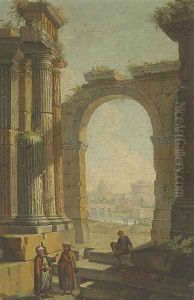Giovacchino Assereto Genoa Paintings
Giovacchino Assereto was a prominent figure in the early Baroque period of Italian painting, born in 1600 in Genoa, Italy. His artistic journey began in his hometown, a bustling port city that was a vibrant center for culture and the arts during the 17th century. Assereto showed an early talent for painting, and his work quickly evolved to reflect the dynamic and emotional intensity characteristic of the Baroque movement. He was deeply influenced by the dramatic chiaroscuro of Caravaggio, yet Assereto infused his works with a distinct personal touch that set him apart from his contemporaries.
Assereto's oeuvre is marked by a strong narrative quality, with a particular emphasis on biblical and mythological themes. He was skilled in capturing the human form, often depicted in moments of intense emotion or dramatic tension. One of his most famous works, 'The Mocking of Christ,' is a testament to his ability to convey deep emotional and spiritual narratives through the interplay of light, shadow, and expression. His paintings are characterized by their vibrant colors, dramatic use of light, and meticulous attention to detail, elements that collectively contribute to the vivid storytelling found in his art.
Throughout his career, Assereto enjoyed considerable success and recognition. He was an influential figure in Genoa's artistic circles, contributing significantly to the city's cultural heritage. Despite his impact, however, he remained relatively unknown outside of Italy for many years, with his work being rediscovered and gaining wider appreciation only in the 20th century. Giovacchino Assereto's legacy is that of a master storyteller through the medium of paint, whose works continue to captivate and inspire with their emotional depth and technical brilliance. He died in 1649, but his contribution to the Baroque movement endures, securing his place among the notable Italian painters of his time.
